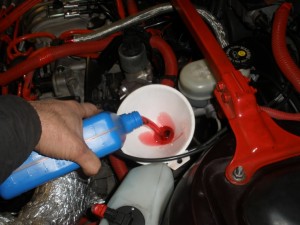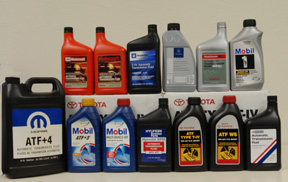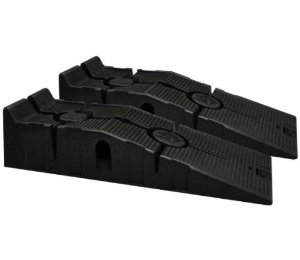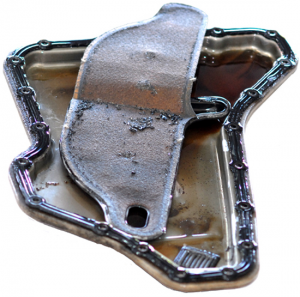A do-it-yourself transmission fluid change is an affordable way to maintain and lengthen your vehicle’s performance and lifetime and it will save you from waiting at a service station and listening to a mechanic try to sell you additional services that your doesn’t need.
What Transmission Do I Have?

To avoid transmission problems, you should check the level and condition approximately once a month using the dipstick. If the color is bright red and it smells sweet, it is still usable, but if it is darker, dirty and/or smells burnt, change it. If the level is low, top it up and check for leaks.
In This Guide
When to Change Transmission Fluid
It is often recommended that you change the fluid in your car every 30,000 to 60,000 miles (see your owner’s manual for the specific advised maintenance schedule).
The frequency should change depending on how tough you are on your transmission and how severe the conditions you drive in are. Tougher conditions include trailer towing, extended high speed driving and driving in cold weather require more frequent changes (every 15,000-24,000 miles give or take).
For automatic transmissions, some manufacturers recommend that the fluid be only changed every 60,000 to 100,000 miles. To tell how hard you’re being on your gearbox, you can install a temperature gauge.
How Much Does it Cost?
 The cost of having your fluid changed at a dealer, service center or independent mechanic ranges from $80-$250. The average is around $100.
The cost of having your fluid changed at a dealer, service center or independent mechanic ranges from $80-$250. The average is around $100.
A do it yourself oil change typically cuts the price in half (at least), and it’s as easy as following a few simple steps as outlined below. To change the fluid yourself, it will cost around $40 to $90 for the filter, gasket and the most important component – the transmission oil. This estimate does not include the cost of the tools required to do the job.
Note: A transmission flush is a different process and typically costs around twice as much as a change.
How to Check
To check to see if your vehicle needs an oil change, simply:
- Turn on your car and let it run a few moments (It is always best to check your oil when it has had time to warm up).
- Wipe the dipstick with a clean cloth or rag; then put it back in and take it out again.
- If the oil is clear but at the low mark, pour in enough fluid to bring it up to the appropriate level. Don’t overfill!
- If the fluid is very dark or smells burnt, it need to be changed. Good clean oil should be bright red/pink in color.

Tools You Will Need
- Fluid – Check your vehicle’s owner’s manual to tell you how many quarts, and the specific type you will need, or speak to a representative at the auto parts store.
- Filter – Check to make sure you get the correct size and quality.
- Torque Wrench – If you don’t have one, don’t fret. A normal socket wrench set will suit you just fine.
- Large pan to catch the fluid – you don’t want to get it on the ground or in the dirt. Try to get one that is larger than the pan (casing) as it will leak out from all sides.
Instructions
Put Your Car on Ramps
 Start by putting your car up on ramps, or jacking up the front part of your vehicle, while using jackstands. Don’t forget to block the wheels. Put old clothes on, this will get kind of messy. You may also want to put newspaper underneath where you will be working so no oil will get on your driveway. It is also very important to dispose of it properly once you are finished. Many auto parts stores either have a place where you can dump the oil, or can tell you how to dispose of it properly. It is not recommended that you empty it in your trash or in your yard.
Start by putting your car up on ramps, or jacking up the front part of your vehicle, while using jackstands. Don’t forget to block the wheels. Put old clothes on, this will get kind of messy. You may also want to put newspaper underneath where you will be working so no oil will get on your driveway. It is also very important to dispose of it properly once you are finished. Many auto parts stores either have a place where you can dump the oil, or can tell you how to dispose of it properly. It is not recommended that you empty it in your trash or in your yard.
Find the Transmission Pan
Locate the transmission pan with the help of your owners manual. Put the oil pan that you will use directly underneath. Remove the bolts slowly and keep your face out of the way. Once the seal is broke on the bolts, the fluid will start dripping out. Put the bolts to the side and let the oil drain completely into the drain pan. Wash the sediments and deposits out of the pan using fluid, not water. Inspect the debris that was in the pan. Doing so can help you determine whether the transmission is running properly or if there is a impending problem in the near future. This can be difficult for the untrained eye to do, so in the words of an ASE Certified Master Automotive Technician (CMAT): “You should see next to no filings or debris, and then only on the first change, subsequent changes should be nearly dead clean. If your car is relatively new and you find debris, there is a problem. You might find just a trace of aluminum shavings, or other very minor contaminants, but the assembly process is so clean, and the newer gearboxes so unforgiving of dirt, that any real accumulation generally means a problem is in development.”

Check the Gasket
Check to see if you need to replace the gasket. If it is well worn, go ahead and replace it. It will save you repair further down the road. Apply a thin layer of RTV sealant to the pan’s flange to ensure a nice tight, leak proof seal.
Remove the Filter
Once it has drained completely, remove the filter. Take caution, the filter has fluid in it as well. Replace it with your new filter, and tighten to the specifications in your owners manual. Then replace the bolts on the pan, tighten them for the first couple threads by hand before using a tool. Now you are ready to add the fresh oil. A funnel is recommended, hardly anyone can do this without spilling.
What Transmission Do I Have?

Once you have completed your oil change, start the car up and let it run a few minutes. Shift your gears a few times, then put in back in park. Now you can check the dipstick. Pull the dipstick out, wipe it on a clean rag, reinsert it, and pull it out again. Hold it level and check to see where the oil is sitting on the stick. It should be sitting on the correct line, usually saying full. Once this is complete, you are ready to take it off the ramps, or let it down from the jack. Then give yourself a pat on the back. You just changed your own fluid and saved money!

Automatic 2007 transmission Silverado, 1500 Chevy gear automatic pops when you press the brake and then you try to put it in drive or park or anywhere pops has a weird smell like a burning smell but I checked the fluid looks OK and also when you’re driving hit jerks so I don’t know what it could be. Maybe it just needs a tranny flush and a filter gasket or it could be more than that I just started doing this couple days ago now it got worse.
My Dodge caravan 2008 3.8 engine dies when I come to a stopwatch and drive
2007 ford f250 super duty 6.0.I told my husband not to drive it with low fluid but I’m a chick what do I know. Anyway, it started out with hard shifting into reverse and then no shift in reverse and delayed or hard shift into drive. Well yesterday it started to smell like something was burning, we had smoke pouring into the cab from the dash vents. I heard a hard grind and lost all boost. When he finally pulled off the road to check it, a puddle of tranny fluid pours out onto the ground. I told him a hundred times to keep up on maintenance with the truck. He promised he would. He wanted a diesel so I bought it for his birthday. He hasn’t had it a year yet. This is the second transition we had to put in it and it’s had the motor replaced already as well.
Tell me how much oil does it take when you change the transmission filter and in any idea how much oil than I need 2001 Ford ranger 3.0 thank you you tell me everything about what I need
Having erratic gear changing and revs high rpms before catching
I have a 97 Silverado 5.7 4wd 4l60e have a p1860 code replaced pwm solenoid trans fluid and filter put back together after about 5 miles of driving the p1860 code comes back on help please Cant pass emissions
Slips when shifting, mainly high gear
Iluuids are full 94 Chevy Silverado c1500
It downshifts from overdrive to drive on freeway
I was on my way to work and I got there. I punched on the time clock. I worked my shift and punched out got Into my 2007 Ford Taurus turned the key and the motor started great just as always. I put the gear shift in to reverse and pushed on the gas pedal nothing happened I thought maybe I set the emergency brake and pulled it out and I put it in reverse again and nothing and I put it in drive nothing I started to freak out. I got a ride home from a co worker. Next day I went down to get the car and see if maybe it might work nothing I had to tow it to a wrecking yard. The guy who owns the wrecking yard sold me a used Transmission for $500 and he has a person putting it in for me for $500 and the car was running great I didn’t notice anything going out or anything no smell no noises or anything but the transmission was just messed up I am still waiting for my car it’s been 2 day’s and I put money down on the job I sure hope he can get it fixed soon as possible I miss my car .
Hope you weren’t just really low on fluid. Could have sprung a small leak. And nothing more than that be wrong with it
2013 Ram 2500 with 5.7 hemi and 6 speed trans. Overheats when pulling my trailer up Hills in 90 degree over over Temps. Never happened until last year.
2002 saturn sl1 code p0746 pressure control solenoid
Shifts really hard especially in reverse.
Problem is can’t find replacement part even after market.
Any ideas?
Slow shifting ,sometimes second doesn’t lockup untill I let off.
lost 2 nd gear
I doesn’t seam to.shift and rpm gage doesn’t move v eff ry much